Karim writes:
- 1st attempt by ADP to ‘sync’ with BLS methodology to more accurately forecast payrolls and avoid persistent large-scale misses of past 2yrs:
- And the prediction is: -693k
- About 200k worse than consensus for Friday.
[top]

Karim writes:
[top]
(email exchange)
>
> Mauer wrote:
>
> My main worry about the efficacy of the fiscal
> stimulus–aside from the international
> spillovers in case it is not supported by equally
> ambitious fiscal plans elsewhere–is this:
> households that face considerable employment
> uncertainty, and hence about their to future
> income prospects, are unlikely to go on a big
> spending spree. Just as banks are hoarding
> cash, households will try to preserve wealth
> by increasing saving at the margin. This
> reduces the marginal propensity to consume,
> and renders the fiscal boost rather ineffective.
>
> Why not try to deal with the looming
> unemployment problem, and the huge sense of
> risk and uncertainty it creates, more directly?
> What I have in mind is subsidizing employment
> directly by providing employers incentives to
> keep people on the job.
>
I look at it this way- if people want to work and earn/save/not spend their paychecks, the output can be directed to public goods and services (goods and services not re-offered for sale) without ‘inflation’.
This is done via federal deficit spending, which adds exactly that amount to non-government ‘savings.’
Trying to increase output that needs to be bought on the market when the desire to consume isn’t there requires that much more deficit spending to eventually induce more spending.
This can/does work, and with government solvency not an issue, it’s a viable political option.
However, seems public purpose is better served via deficit spending, producing public goods and services when the desire for private goods and services is suppressed?
For a narrow example to make the point, why try to induce more car production and employment building cars and marketing cars when the demand isn’t there due to desires to save rather than spend? Instead employ people to fix the roads and bridges until demand for vehicles picks up?
That said, my best guess is that given more income, spending will go up substantially and in short order, due to delayed purchases due to lack of income.
Warren
[top]
And not long ago they promised not to do this- not nice!
Gazprom cuts supply to Europe via Ukraine
Source: The New York Times
by Stephen Castle and Andrew E. Kramer
[top]
Obama Says Deficit Likely to Approach $1 Trillion
by Julianna Goldman and Roger Runningen
Jan 6 (Bloomberg) — President-elect Barack Obama said he expects to inherit a $1 trillion budget deficit and that similar shortfalls are in store “for years to come” as the government grapples with a recession and other spending demands.
A “trillion dollar deficit will be here before we even start the next budget,” Obama said after meeting in Washington with his economic advisers, including Peter Orszag, who has been designated as director of the Office of Management and Budget. “Potentially we’ve got trillion-dollar deficits for years to come, even with the economic recovery we are working on.”
Obama said he wants his budget and economic teams to craft a stimulus plan that stabilizes the economy and begins the process of “getting our budget under control.” That includes barring lawmakers from inserting pet spending projects, known as earmarks, into the legislation, he said.
‘Unsustainable’ Spending
Some congressional Democrats, including Senate Budget Committee ChairmanKent Conrad of North Dakota, are calling the incoming administration to come up with a long-term plan to cut the deficit. Conrad said today on Bloomberg TV that the nation’s financial situation is “unsustainable for the long term.”
A plan for dealing with budget imbalances “has to be put in place” as the new administration and Congress craft a stimulus plan, he said.
Obama said he agrees.
“It’s not just Democratic or Republican colleagues on the Hill that are concerned about this, I’m concerned about this,” Obama said. “I’m going to be willing to make some very difficult choices in how we get a handle on this deficit.”
Advisers
Along with Orszag, those who took part in the session were Timothy Geithner, Treasury secretary-designate; Christina Romer, director-designate of the Council of Economic Advisors and Lawrence Summers, director-designate of the National Economic Council.
[top]
Just in case you thought the FOMC understands monetary operations and reserve accounting.
(And I didn’t see any discussion on the swap lines to foreign CBs)
Participants discussed the potential advantages and disadvantages of setting quantitative targets for bank reserves or the monetary base. Some were of the view that quantitative targets for an increasing reserve base could be effective in preventing deflationary dynamics and useful in communicating to the public the Committee’s determination to take the steps needed to avoid such an outcome. Several other participants, however, noted that increases in excess reserves or the monetary base, by themselves, might not have a significant stimulative effect on the economy or prices because the normal bank intermediation mechanism appeared to be impaired, and banks may not be willing to lend their excess reserves. Conversely, a decline in excess reserves or the monetary base would not necessarily be contractionary if it occurred in the context of improving financial market conditions. A few of those who supported quantitative base or reserve targets did so because they saw them as helping to coordinate the actions of the Board of Governors, which is responsible for authorizing most special liquidity and lending facilities, and the Committee, which is responsible for open market operations. Most participants, however, were of the view that such coordination would best be achieved by continued close cooperation and consultation between the Committee and the Board. Going forward, consideration will be given to whether various quantitative measures would be useful in calibrating and communicating the stance of monetary policy.
Members debated how best to communicate their decisions regarding monetary policy actions. Since the large amount of excess reserves in the system would limit the Federal Reserve’s control over the federal funds rate, several members thought that it might be preferable not to set a specific target for the federal funds rate. Indeed, those members felt that lack of an explicit target could be helpful, in that it would focus attention on the shift in the policy framework from targeting the federal funds rate to the use of balance sheet policies and communications about monetary policy as a way of providing further monetary stimulus. A few members stressed that the absence of an explicit federal funds rate target would give banks added flexibility in pricing loans and deposits in the current environment of unusually low interest rates. However, other members noted that not announcing a target might confuse market participants and lead investors to believe that the Federal Reserve was unable to control the federal funds rate when it could, in fact, still influence the effective federal funds rate through adjustments of the interest rate on excess reserves and the primary credit rate. The members decided that it would be preferable for the Committee to communicate explicitly that it wanted federal funds to trade at very low rates; accordingly, the Committee decided to announce a target range for the federal funds rate of 0 to 1/4 percent. Members also agreed that the statement should indicate that weak economic conditions were likely to warrant exceptionally low levels of the federal funds rate for some time. The members emphasized that their expectation about the path of the federal funds rate was conditioned on their view of the likely path of economic activity.
[top]
Contraction for all of 2009 and core inflation to fall through 2010.
In the forecast prepared for the meeting, the staff revised down sharply its outlook for economic activity in 2009 but continued to project a moderate recovery in 2010. Real GDP appeared likely to decline substantially in the fourth quarter of 2008 as conditions in the labor market deteriorated more steeply than previously anticipated; the decline in industrial production intensified; consumer and business spending appeared to weaken; and financial conditions, on balance, continued to tighten. Rising unemployment, the declines in stock market wealth, low levels of consumer sentiment, weakened household balance sheets, and restrictive credit conditions were likely to continue to hinder household spending over the near term. Homebuilding was expected to contract further. Business expenditures were also likely to be held back by a weaker sales outlook and tighter credit conditions. Oil prices, which dropped significantly during the intermeeting period, were assumed to rise over the next two years in line with the path indicated by futures market prices, but to remain below the levels of October 2008. All told, real GDP was expected to fall much more sharply in the first half of 2009 than previously anticipated, before slowly recovering over the remainder of the year as the stimulus from monetary and assumed fiscal policy actions gained traction and the turmoil in the financial system began to recede. Real GDP was projected to decline for 2009 as a whole and to rise at a pace slightly above the rate of potential growth in 2010. Amid the weaker outlook for economic activity over the next year, the unemployment rate was likely to rise significantly into 2010, to a level higher than projected at the time of the October 28-29 FOMC meeting. The disinflationary effects of increased slack in resource utilization, diminished pressures from energy and materials prices, declines in import prices, and further moderate reductions in inflation expectations caused the staff to reduce its forecast for both core and overall PCE inflation. Core inflation was projected to slow considerably in 2009 and then to edge down further in 2010.
Policy..low for long plus nontraditional
They agreed that maintaining a low level of short-term interest rates and relying on the use of balance sheet policies and communications about monetary policy would be effective and appropriate in light of the sharp deterioration of the economic outlook and the appreciable easing of inflationary pressures. Maintaining that level of the federal funds rate implied a substantial further reduction in the target federal funds rate. Even with the additional use of nontraditional policies, the economic outlook would remain weak for a time and the downside risks to economic activity would be substantial. Moreover, inflation would continue to fall, reflecting both the drop in commodity prices that had already occurred and the buildup of economic slack; indeed some members saw significant risks that inflation could decline and persist for a time at uncomfortably low levels.
With some talk of abandoning a target altogether…
A few members stressed that the absence of an explicit federal funds rate target would give banks added flexibility in pricing loans and deposits in the current environment of unusually low interest rates. However, other members noted that not announcing a target might confuse market participants and lead investors to believe that the Federal Reserve was unable to control the federal funds rate when it could, in fact, still influence the effective federal funds rate through adjustments of the interest rate on excess reserves and the primary credit rate. The members decided that it would be preferable for the Committee to communicate explicitly that it wanted federal funds to trade at very low rates; accordingly, the Committee decided to announce a target range for the federal funds rate of 0 to 1/4 percent.
[top]
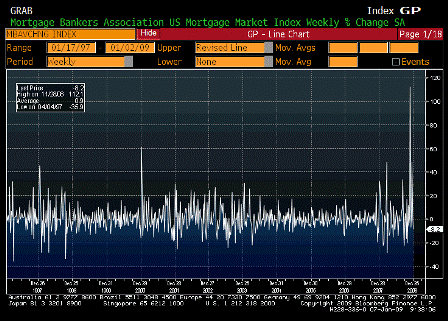
| Survey | n/a |
| Actual | -8.2% |
| Prior | 0.0% |
| Revised | n/a |
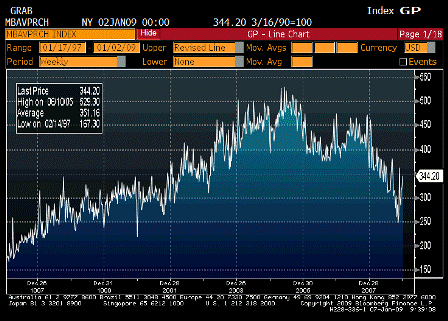
| Survey | n/a |
| Actual | 344.20 |
| Prior | 320.90 |
| Revised | n/a |
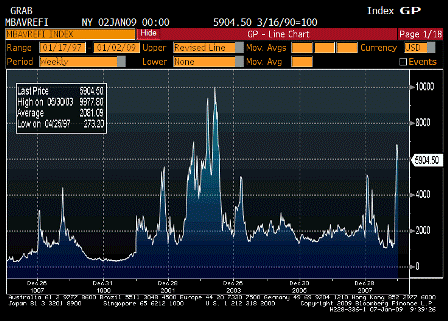
| Survey | n/a |
| Actual | 5904.50 |
| Prior | 6733.80 |
| Revised | n/a |
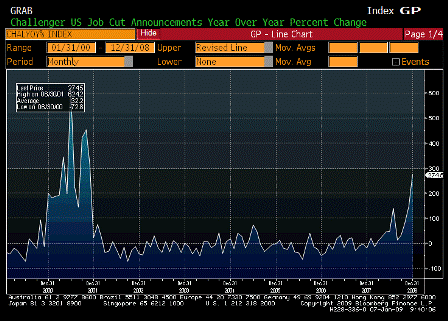
| Survey | n/a |
| Actual | 274.5% |
| Prior | 148.4% |
| Revised | n/a |
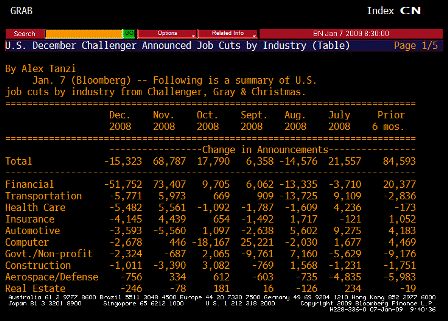
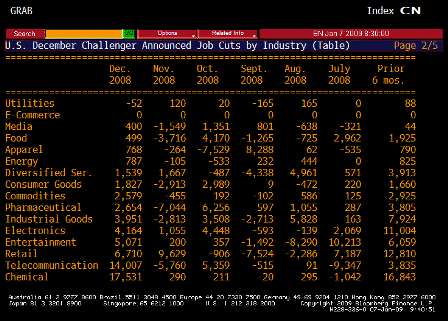
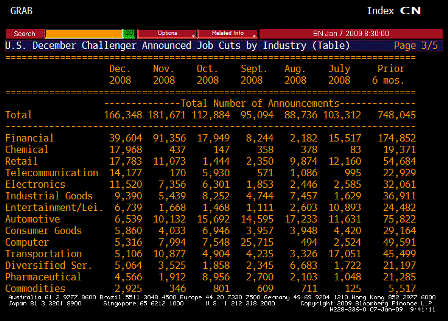
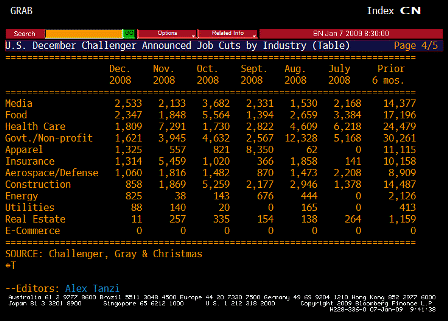
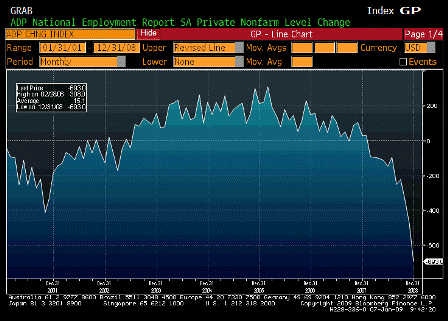
| Survey | -495K |
| Actual | -693K |
| Prior | -250K |
| Revised | -476K |
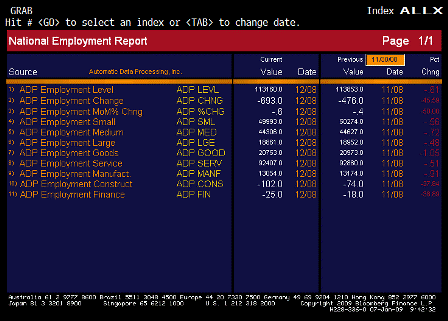
[top]
Karim writes:
Modest improvement from all-time lows
Anecdotals quite weak:
| Dec. 2008. | Nov. 2008 | |
| Index | 40.6 | 37.3 |
| Prices Paid | 36.0 | 36.6 |
| New Orders | 39.9 | 35.4 |
| Employment | 34.7 | 31.3 |
| Export Orders | 39.5 | 34.5 |
| Imports | 32.5 | 40.0 |
[top]
No mention of the $300 billion they’ve borrowed from the Fed to stay afloat…
ECB’s Stark Says Euro Prevented Worse Crisis Fall-Out, RBB Says
Jan. 5 (Bloomberg) — The euro has shielded the nations using the single currency from greater fall-out from the financial crisis, European Central Bank Executive Board member Juergen Stark said in an interview with German radio station RBB.
“The euro has saved us in the euro area from worse economic consequences,” Stark said in the interview broadcast on Jan. 3 and posted on RBB’s Web site.
Before the introduction of the euro 10 years ago, turbulence similar to that experienced last year also led to “considerable tensions” between the European currencies and governments, Stark told the broadcaster. The euro prevented that, he said.
Stark said in the interview that the single currency has been a “large success” and that the ECB has handled its challenges well.
[top]
| BOJ Struggling To Find Ways To Combat Deflation |
Looks like they got it right:
BOJ Struggling To Find Ways To Combat Deflation (Nikkei) – “We have run out of ammunition,” said a senior BOJ official. “We aren’t sure what we can do now.” BOJ Gov. Masaaki Shirakawa is deeply skeptical about the idea of lowering the interest rate down to zero – a policy the bank adopted once. Shirakawa thinks the approach would be ineffective and detrimental to the functioning of the money market. The central bank is also unwilling to revive the so-called quantitative easing. The central bank says it is not clear that the five years of the BOJ’s quantitative easing from March 2001 really produced expected effects. In particular, many in the BOJ are critical of the bank’s attempt to stimulate economic growth by increasing money supply through setting targets for the reserve account balances commercial banks are required to maintain at the central bank. It is now accepted wisdom at the BOJ that this tactics did not work.
Right!
Slowly coming around to the notion that output and employment are functions of fiscal balance.
| Local Govts On The Hook For Y30tln In ‘Hidden’ Liabilities |
| Toyota Extends Japan Output Suspension By 11 Days |
| Toyota, Nissan Lead Drop as Japan Car Sales Fall to 28-Year Low |
So maybe the problem with the US car industry is the macro economy more so than management issues???
| Japan Business Leaders Say Dollar May Trade at 100 Yen in 2009 |
Maybe they know something about the return of MOF USD purchases?
[top]